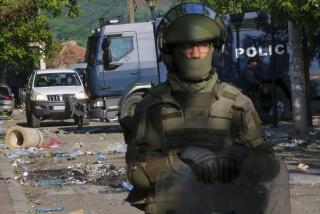Serbs Aim at Other Croatian Strongholds : Yugoslavia: Fighting is also reported on Croatia’s Adriatic coast. Some officials say that a deal may be near for a U.N. peacekeeping force.
- Share via
ZAGREB, Croatia — As officials filled mass graves with hundreds of the dead left by a brutal three-month siege of Vukovar, Serbian forces turned their attention Thursday to other Croatian strongholds of eastern Croatia.
Heavy fighting was also reported on the Adriatic coast of the secessionist Croatian republic, with 2,000 refugees reportedly fleeing. But officials said that U.N. envoy Cyrus R. Vance may be close to winning support for a U.N. peacekeeping force for Croatia.
In Zagreb, the Croatian capital, Defense Ministry and diplomatic sources reported a massive federal army buildup around Osijek, 20 miles northwest of Vukovar. Osijek is the capital of the Slavonia region of Croatia. The reports could not be immediately confirmed, but reservists in Vukovar said they had been told their next targets were Osijek and Vinkovci, a major rail junction west of Vukovar.
Osijek is nearly encircled by Serb-dominated forces and has been shelled almost daily for several months. The barrages reportedly intensified Thursday.
With the capture of Vukovar over the weekend, federal troops and Serbian irregulars gained control over a slice of eastern Croatia along the Danube River. The capture of Osijek and Vinkovci would ensure domination of a much broader swath.
Meanwhile, Vance, a former U.S. secretary of state, pressed his mission to try to persuade Croatia and its rival, Serbia, to agree on terms for U.N. forces to be sent to Croatia to end the 4 1/2-month-old civil war.
Vance met Thursday night with Serbian President Slobodan Milosevic and with the leader of the ethnic Serbian separatists of Croatia. The Yugoslav news agency Tanjug quoted Milosevic as saying a “major step” has been achieved toward “establishing peacekeeping forces which will protect, above all, the Serbian people in the regions, their freedom and safety.”
President Alija Izetbegovic of Bosnia-Herzegovina, who also met with Vance, was quoted as saying that Croatian, Serbian and federal leaders had apparently agreed to Vance’s proposal.
There were no details of any plan, however, and Croatian officials had no comment. Both sides have agreed in principle to peacekeepers but disagree on where they should be posted.
The fighting began in Croatia after the republic declared independence on June 25. Since then, Serbian-led forces have seized a third of the republic’s territory. Between 3,000 and 7,000 people are estimated to have died in the fighting, hundreds of them in Vukovar, which fell to Serb-led forces over the weekend.
The bodies of most of those killed still lay in wrecked houses and streets this week and were being collected Thursday and put in huge graves dug in parks and yards, according to radio reports in Belgrade.
Both sides alleged there were massacres in Vukovar and elsewhere, but the reports could not be confirmed.
No loss has been more devastating to Croatia than the fall of Vukovar, a leading symbol of Croatia’s resistance.
The chief architect of the defense of the city, Milan Dedakovic, has been detained for an investigation of allegations that he undermined the defenses he built.
The former Yugoslav air force pilot was arrested outside his Zagreb home Wednesday, his daughter Dubravka said in a telephone interview. Croatian radio said Dedakovic was charged with “leaving the battlefield and failing to report on the situation.”
Refugees were fleeing the Zadar area on the Adriatic coast after heavy fighting there.
Croatian Radio said that about 2,000 people had fled villages east of Zadar on Thursday.
More to Read
Sign up for Essential California
The most important California stories and recommendations in your inbox every morning.
You may occasionally receive promotional content from the Los Angeles Times.













